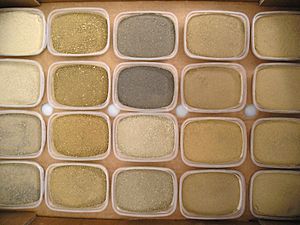Soil classification facts for kids
Soil classification is like organizing your toys into different boxes based on what they are or how you use them! For soil, it means putting different types of soil into groups. These groups are based on what the soil is like and what it can be used for.
Scientists look at soil in two main ways to classify it. They might look at how the soil was formed (this is called pedogenesis). Or, they might look at what the soil looks like (this is called soil morphology). Even though these are different ways of looking at soil, they usually lead to similar ways of grouping them.
Contents
Why Do We Classify Soil?
Classifying soil helps us understand it better. It's important for many reasons, like:
- Farming: Knowing the soil type helps farmers choose the best crops to grow. Some plants like sandy soil, while others need clay.
- Building: When people build houses or roads, they need to know if the soil is strong enough to hold heavy structures.
- Environment: Understanding soil helps us protect nature. It shows us how water moves through the ground and where plants can grow best.
- Science: Scientists can study how soils change over time and how they affect the environment.
How Do Scientists Classify Soil?
Scientists use many features to classify soil. They look at things you can see and feel, and also things you need special tools to find out.
What Soil Looks Like (Morphology)
When scientists look at soil morphology, they check these things:
- Color: Soil can be many colors, like black, brown, red, or yellow. Darker soils often have more organic matter (decayed plants and animals).
- Texture: This is how the soil feels. Is it sandy, silty, or clayey?
- Sand feels gritty. It has large particles.
- Silt feels smooth, like flour. Its particles are medium-sized.
- Clay feels sticky when wet and hard when dry. It has very tiny particles.
- Structure: This is how soil particles clump together. They can form blocks, crumbs, or plates. This affects how water and air move through the soil.
- Layers (Horizons): If you dig a hole, you'll often see different layers of soil. Each layer, called a horizon, has unique features.
How Soil Forms (Pedogenesis)
Pedogenesis looks at the processes that create soil. These include:
- Parent Material: This is the original rock or material the soil formed from. It can be bedrock, sand, or even old lava.
- Climate: Rain and temperature play a big role. Wet, warm climates often create different soils than dry, cold ones.
- Living Organisms: Plants, animals, and tiny microbes in the soil help break down organic matter and create new soil.
- Topography: The shape of the land (flat, hilly, sloped) affects how water drains and where soil collects.
- Time: Soil formation is a very slow process. It can take hundreds or thousands of years for soil to develop.
Common Soil Classification Systems
Different countries and scientists use various systems to classify soil. Some well-known ones include:
- USDA Soil Taxonomy: This is a very detailed system used in the United States. It has many levels, from broad categories to very specific types.
- World Reference Base for Soil Resources (WRB): This system is used internationally. It helps scientists around the world talk about soil in a common language.
Understanding soil classification helps us use our land wisely and protect this important natural resource for the future.
See also
 In Spanish: Clasificación de suelos para niños
In Spanish: Clasificación de suelos para niños


